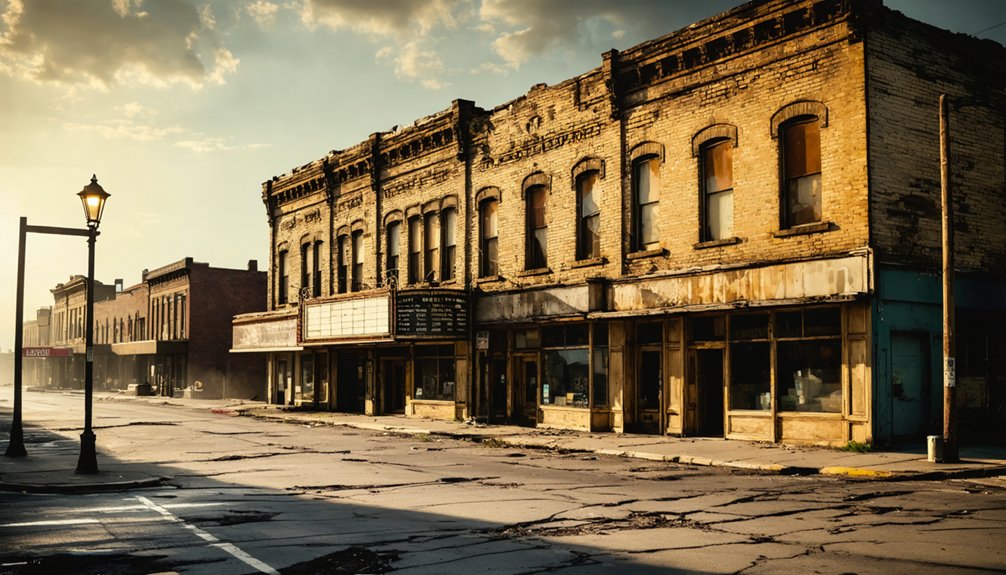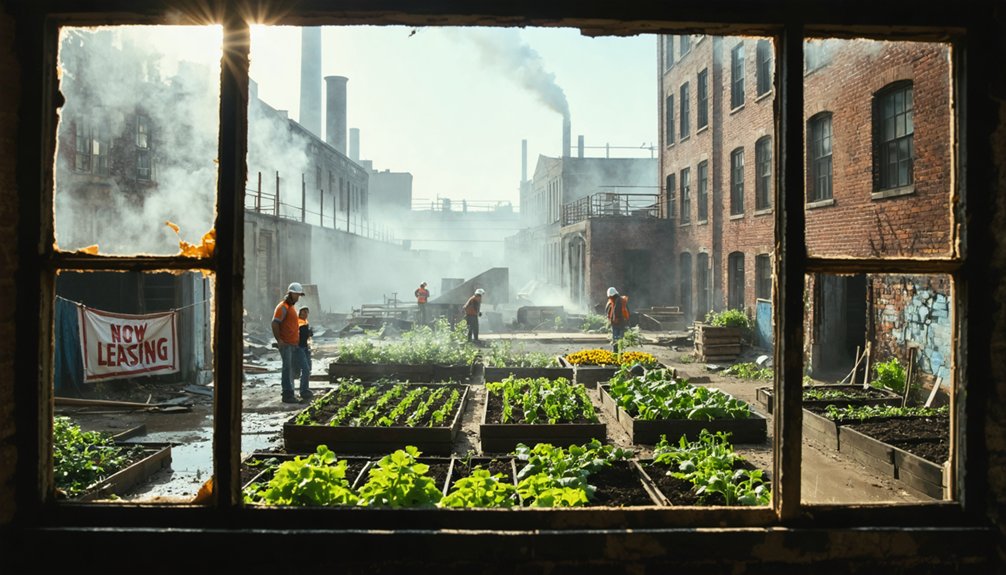The Rust Belt offers a compelling landscape of abandoned factories and empty streets where America’s industrial might once thrived. You’ll find cities like Youngstown, Detroit, and Cleveland dramatically transformed by manufacturing collapse following NAFTA and globalization. Many towns have lost over 40% of their population, leaving behind industrial archaeology “frozen in time.” Yet amid decay, you’ll discover revitalization stories in Pittsburgh and Milwaukee that reveal the region’s complex economic evolution.
Key Takeaways
- Youngstown exemplifies Rust Belt abandonment with 5,000 manufacturing jobs lost in a single day in 1977.
- Detroit’s population plummeted from 1.8 million to 673,000 by 2018, creating vast urban landscapes of vacant buildings.
- Abandoned factories and empty streets symbolize economic devastation across former industrial powerhouses like Pittsburgh and Cleveland.
- Post-NAFTA decline led to population losses exceeding 40% in many manufacturing communities, leaving neighborhoods frozen in time.
- Industrial archaeology reveals the rapid transformation of once-thriving communities into modern ghost towns with poverty rates reaching one-third.
The Rise and Fall of America’s Industrial Heartland

In the aftermath of the Civil War, America experienced an unprecedented industrial transformation that would redefine its economic landscape for generations to come. Railroad expansion catalyzed this revolution, connecting vast resources while shifting the nation from agricultural dominance to manufacturing supremacy.
Cities like Pittsburgh, Detroit, and Chicago emerged as industrial powerhouses where you could witness steel furnaces illuminating night skies. By 1893, the United States had become the world’s leading industry through extraordinary post-war economic growth.
This industrial nostalgia reflects an era when factory jobs tripled between 1860-1890, pulling millions from farms into urban centers. The Manufacturing Belt thrived on Great Lakes access and immigrant labor, creating unprecedented prosperity.
Yet this economic resilience would eventually falter as the workforce shifted from self-employment to wage dependency. The economic challenges intensified during the 1979-1982 period when Volcker shock led to higher interest rates that made American products expensive internationally. What once represented American economic might would later become known as the “Rust Belt”—casualties of changing global markets.
Ghost Towns of the Former Manufacturing Belt
Across America’s former industrial heartland, once-vibrant manufacturing towns now stand eerily silent, their abandoned factories and empty streets serving as stark monuments to economic devastation.
Places like Youngstown, where 5,000 workers lost their livelihoods overnight in 1977, exemplify the rapid transformation from prosperity to desolation.
The Youngstown collapse illustrates America’s industrial tragedy—thousands of lives upended in a single devastating moment.
Industrial archaeology reveals communities frozen in time—Bruceton’s textile plants, Muncie’s 2,000 abandoned homes, and Flint’s shuttered auto factories. Similar to Bodie, California, these locations display scenes of everyday life with kitchen tables set for meals that were never eaten after industries collapsed.
These sites document America’s manufacturing collapse that began in the 1950s. Ghost town legends permeate these areas where populations plummeted dramatically, with Cleveland shrinking from 900,000 to just 360,000 residents.
The physical remains—abandoned factories, empty homes, and deserted public spaces—provide critical evidence of how globalization, automation, and policy decisions hollowed out America’s industrial core. In Johnstown and Monessen, the manufacturing decline left thousands of properties vacant, contributing to the deterioration of once-thriving communities.
Urban Decay and Economic Devastation in Former Factory Cities

You’ll encounter stark remnants of post-NAFTA industrial collapse in former manufacturing hubs where population losses exceeded 40 percent and poverty rates climbed to one-third of residents.
Factory closures in these communities triggered cascading economic downturns, with neighborhoods experiencing varying degrees of decline based on their pre-existing housing prices and income levels.
Detroit’s transformation from a 1.8 million resident metropolis to a city of 673,000 by 2018 exemplifies the profound demographic shifts that accompany abandoned industrial landscapes. Cities with higher college education levels demonstrated stronger employment recovery rates after deindustrialization, contrasting sharply with the widespread decline seen in the Rust Belt. These urban areas continue to struggle with the legacy of segregation that compounds economic challenges and limits revitalization efforts.
Post-NAFTA Ghost Towns
While the North American Free Trade Agreement (NAFTA) promised economic growth through international commerce, its implementation in 1994 accelerated the hollowing out of once-thriving manufacturing centers across America’s industrial heartland.
Walking through these post-NAFTA ghost towns today, you’ll witness the stark reality of trade policy consequences: cities like Detroit, Buffalo, Cleveland, and Pittsburgh have lost over 45% of their populations in just four decades. The narrative of decline overlooks that income growth statistics actually show a 56% increase in median personal income for Rust Belt residents from 1960 to 2023.
The economic displacement has been profound—manufacturing employment plummeted nearly 33% between 1969-1996. In neighborhoods where factories once hummed with activity, you’ll find abandoned buildings, crumbling infrastructure, and dramatically reduced tax bases. These areas have experienced significant urban shrinkage, with long-term population and economic declines affecting water, energy, and carbon cycling patterns.
Most devastating is what these statistics represent: median household incomes fell approximately 30% in Cleveland and Detroit, with communities lacking college-educated workforces suffering the most severe, often permanent, economic wounds.
Abandoned Factory Portraits
The physical manifestation of economic collapse stands frozen in time within America’s abandoned factories—monolithic structures that now serve as haunting monuments to industrial decline.
As you explore these spaces, you’ll witness the abandoned beauty of approximately 4,600 vacant properties in Johnstown and 6,000 in Youngstown—each telling stories of communities that lost 45% of their populations between 1970-2006.
These architectural ghosts evoke industrial nostalgia while revealing stark economic realities: 7.3% unemployment and 35% poverty rates in once-thriving manufacturing hubs.
The urban deterioration is particularly concentrated in historically Black neighborhoods, where census data reveals over 269 tracts lost more than half their housing units. The excessive property tax assessments have forced many homeowners to abandon their properties when taxes exceed their homes’ actual market value.
Each rusting beam and broken window represents not merely physical decay, but the dissolution of social cohesion, economic opportunity, and community significance. The dramatic cost reduction in transporting goods between 1950 and 1970 accelerated the migration of manufacturing away from these once-bustling industrial centers.
NAFTA’s Impact on Rust Belt Communities
Since the North American Free Trade Agreement‘s implementation in 1994, Rust Belt communities have experienced profound economic transformations with complex and sometimes contradictory outcomes.
While NAFTA benefits include the creation of higher-paying export jobs and access to essential Canadian and Mexican markets—with Midwest states generating 48% of all U.S. exports to Canada—many communities faced significant disruption.
NAFTA created higher-paying export opportunities while simultaneously disrupting community economic foundations across the industrial heartland.
Rust Belt states contribute 26% of all export-derived GDP, making trade agreements particularly consequential for regional economies. Simultaneously, manufacturing employment shifted southward, with the Rust Belt’s share of manufacturing exports plummeting from 50% to 21% by 2021.
This regional restructuring reflects broader patterns where NAFTA’s advantages and challenges distribute unevenly.
Though NAFTA created approximately 5 million U.S. jobs, its dissolution would primarily impact specific industries rather than cause widespread economic damage.
Abandoned Factories and Vacant Neighborhoods

Abandoned factories and vacant neighborhoods stand as physical manifestations of NAFTA’s economic consequences throughout the Rust Belt region. When you explore cities like Detroit, Cleveland, Buffalo, and Pittsburgh, you’ll encounter haunting abandoned structures that represent the 45 percent population decline these metropolitan areas experienced between 1970 and 2006.
Urban exploration reveals how population losses disproportionately affected certain neighborhoods, creating patchworks of vacancy amid struggling communities. As manufacturing employment plummeted nearly 33 percent from 1969 to 1996, these physical voids became emblematic of economic deterioration.
The remaining residents faced declining median household incomes—Cleveland and Detroit saw approximately 30 percent drops in real terms.
These vacant industrial landscapes didn’t emerge solely from foreign competition but also from domestic migration to southern states with lower labor costs and fewer environmental regulations.
Successful Revitalization Stories Across the Region
While industrial decline left profound scars across the Rust Belt landscape, numerous cities have engineered remarkable comebacks that demonstrate the region’s resilience and capacity for reinvention.
Pittsburgh’s transformation into “Roboburgh” exemplifies successful revitalization strategies, focusing on robotics and high-tech innovation, while Cleveland and Baltimore cultivated robust innovation ecosystems through medical research and biotechnology sectors.
The innovation renaissance of America’s industrial heartland proves that rust can indeed transform into technological gold.
Cincinnati revitalized its Over-the-Rhine district from high-poverty to a vibrant startup hub, while Milwaukee enhanced lakefront connectivity through strategic urban planning.
St. Louis’s T-REX incubator now houses over 200 companies, and Grand Rapids assembled cross-sector coalitions that yielded impressive job growth.
Pittsburgh’s recognition as America’s most livable city and its second-place ranking for economic mobility underscore how these post-industrial communities have leveraged their industrial heritage to forge promising new economic identities.
Frequently Asked Questions
What Safety Precautions Should Urban Explorers Take in Abandoned Industrial Sites?
You’ll need extensive safety gear including respirators, sturdy boots, and protective clothing. Always establish emergency contacts, thoroughly research sites beforehand, and remain vigilant for structural, chemical, and biological hazards.
Are There Legal Consequences for Photographing or Entering These Abandoned Properties?
You’re walking on thin ice legally. Despite appearing abandoned, these properties have owners with property rights. Trespassing laws typically classify unauthorized entry as a misdemeanor, resulting in fines or imprisonment regardless of your photography intentions.
Which Rust Belt Towns Have Paranormal Activity Reported in Abandoned Buildings?
You’ll find documented ghost sightings in Alton (Illinois), Youngstown (Ohio), and Pennsylvania’s mining towns like Whiskey Run and Laurel Run. These haunted locations feature prominent paranormal activity in their decaying industrial structures.
How Has Environmental Contamination Affected Health in Former Industrial Communities?
You’re 33% more likely to develop lung cancer in these regions. Contamination sources like industrial chemicals, brownfields, and PFAS create significant health disparities, reducing life expectancy in former manufacturing hubs across the Rust Belt.
What Photography Equipment Works Best for Documenting Abandoned Industrial Architecture?
You’ll need a full-frame mirrorless camera for dynamic range, wide-angle lenses for spatial context, tripod stability for long exposures, and tilt-shift lenses to maintain architectural integrity in low-light conditions.
References
- https://www.industryweek.com/talent/article/22028380/the-abandonment-of-small-cities-in-the-rust-belt
- https://247wallst.com/special-report/2016/11/12/20-american-ghost-towns/
- https://www.loveexploring.com/gallerylist/127789/then-and-now-us-rust-belt-cities-that-bounced-back
- https://www.commercialcafe.com/blog/rust-belt-cities-comeback-stories/
- https://en.wikipedia.org/wiki/Rust_Belt
- https://www.youtube.com/watch?v=orM7mOwy11k
- https://www.midstory.org/urbexers-are-documenting-americas-post-industrial-past/
- https://www.britannica.com/place/Rust-Belt
- https://www.whobuiltamerica.org/reader/chapter/progress-and-poverty-industrial-capitalism-in-the-gilded-age-1877-1893
- https://www.loc.gov/classroom-materials/united-states-history-primary-source-timeline/rise-of-industrial-america-1876-1900/overview/



